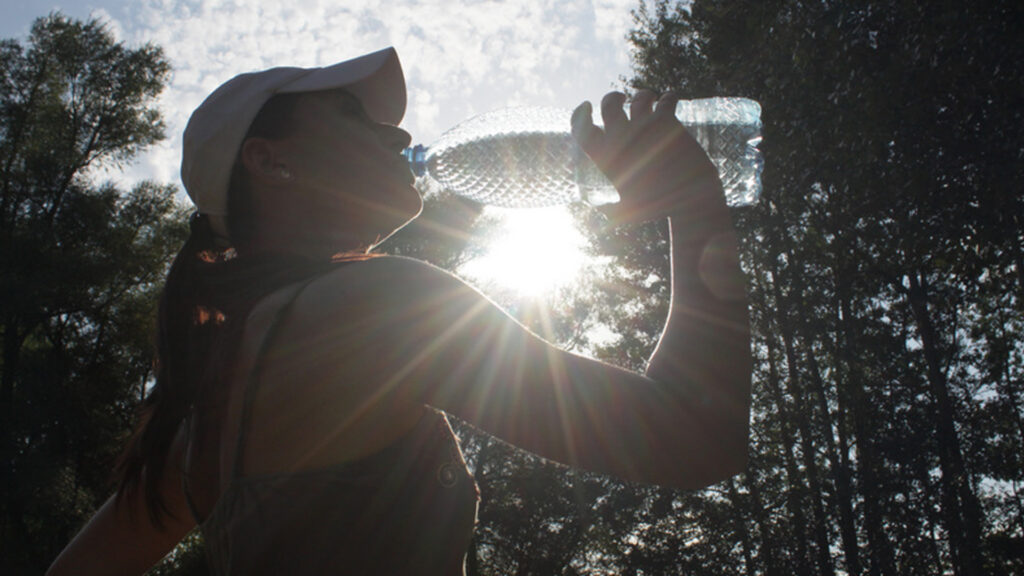By Barbara Gutierrez, University of Miami
The first days of July were the hottest days on record. Ever. In the entire world.
For weeks, residents in the Southwest United States, including Arizona, New Mexico, Texas and the Central Plains, have been battling temperatures of more than 100 degrees Fahrenheit. South Florida also has been under constant heat advisories.
The earth is getting hotter, and climate experts predict that it will continue to do so.
Even though humans need the sun to live, its rays can damage our skin and its heat and the ensuing humidity can harm us. As the summer lingers, we all have to learn how to best mitigate that heat. In South Florida, where humidity is high, it can be more of a challenge, according to sport sciences faculty members at the University of Miami, who can attest to how the heat can affect us.
“Our bodies sweat to cool down,” said Wesley “Wes” Smith, assistant professor of professional practice in the School of Education and Human Development. “But in humid places like Miami, the air is too damp for sweat to evaporate effectively, making it harder for us to cool down and potentially leading to overheating or even heat stroke.”
When bodies overheat the heart works harder and the body redirects blood flow to the skin to help cool off, but this means less blood returns to the heart, said Smith. To make up for this, our heart rate increases. This extra work can strain the heart, especially in people with heart conditions, he added.
Heat illnesses can range from something mild, like heat cramps and heat exhaustion, to severe heatstroke. Heat exhaustion typically presents as excessive sweating, fatigue, a racing heart rate and lightheadedness, especially when standing suddenly.
Despite the heat, the skin may feel cool and clammy. Immediate removal from the heat and rehydration with cool fluids are essential to prevent progression to heat stroke, Smith explained. A heatstroke manifests as dry, hot skin, possible unconsciousness and convulsions. This life-threatening condition requires immediate cooling measures and professional medical intervention, he added.

Although having full heatstroke is rare for someone doing light exercise under the sun, experts agree that keeping hydrated is crucial.
“With athletes, here in South Florida, they have to make sure that they hydrate during the event but also that they hydrate before and that includes the day before and hours before,” said Maggie Aldousany, associate professor of professional practice in the Department of Kinesiology and Sport Sciences. “Once they feel thirsty, they are already dehydrated.”
Avoiding alcohol, caffeine and beverages with cola is also important for those who plan to spend hours under the sun, since those drinks tend to dehydrate the body.
Aldousany also pointed out that folks should avoid being outside during peak sun hours — the sun is usually at its strongest between 10 a.m. and 4 p.m. If engaging in exercise, they should do so either very early in the morning or in the cooler hours of the evening.
Arlette Perry, professor in the School of Education and Human Development, runs the THINK Camp every summer. The camp teaches adolescents how to keep healthy through proper nutrition and exercise. The participants take part in outdoor exercises in the afternoon hours.
“This year we have been struggling because the heat index has been so high,” she said.
The camp provides everyone extra water and sports drinks, which contain glucose and electrolytes such as sodium and potassium that are similar to what is found in your bloodstream. As one sweats, the body loses salt and electrolytes, which may exacerbate heat illness, she pointed out.
Also, Perry said that during the summer it is better for people to wear visors, rather than hats “because hats can trap the heat in the head. Protecting the brain temperature is important.” Cooling towels placed around the neck also help one to maintain a comfortable body temperature.
Carie Penabad, professor in the School of Architecture, said that people should keep in mind that there are also built environments that are more amenable to reducing the effects of the sun. Cities like Coral Gables, with luscious landscapes and mature trees, create canopies that can substantially mitigate heat.
“Landscape significantly reduces heat gain because as the trees mature they create ample shade canopies that allow people to walk, jog or play for much longer periods of time,” said Penabad.
Our buildings also can respond to the heat through the use of architectural elements such as porches, colonnades and deep overhangs, all historic characteristics of buildings throughout the tropical world, she noted.
“These elements help to protect us from the harsh light and promote shade and ventilation,” she said.
This piece was originally published at https://news.miami.edu/stories/2023/07/know-how-to-deal-with-this-scorching-summer.html
If you are interested in submitting an opinion piece to The Invading Sea, email Editor Nathan Crabbe at ncrabbe@fau.edu. Sign up for The Invading Sea newsletter by visiting here.



